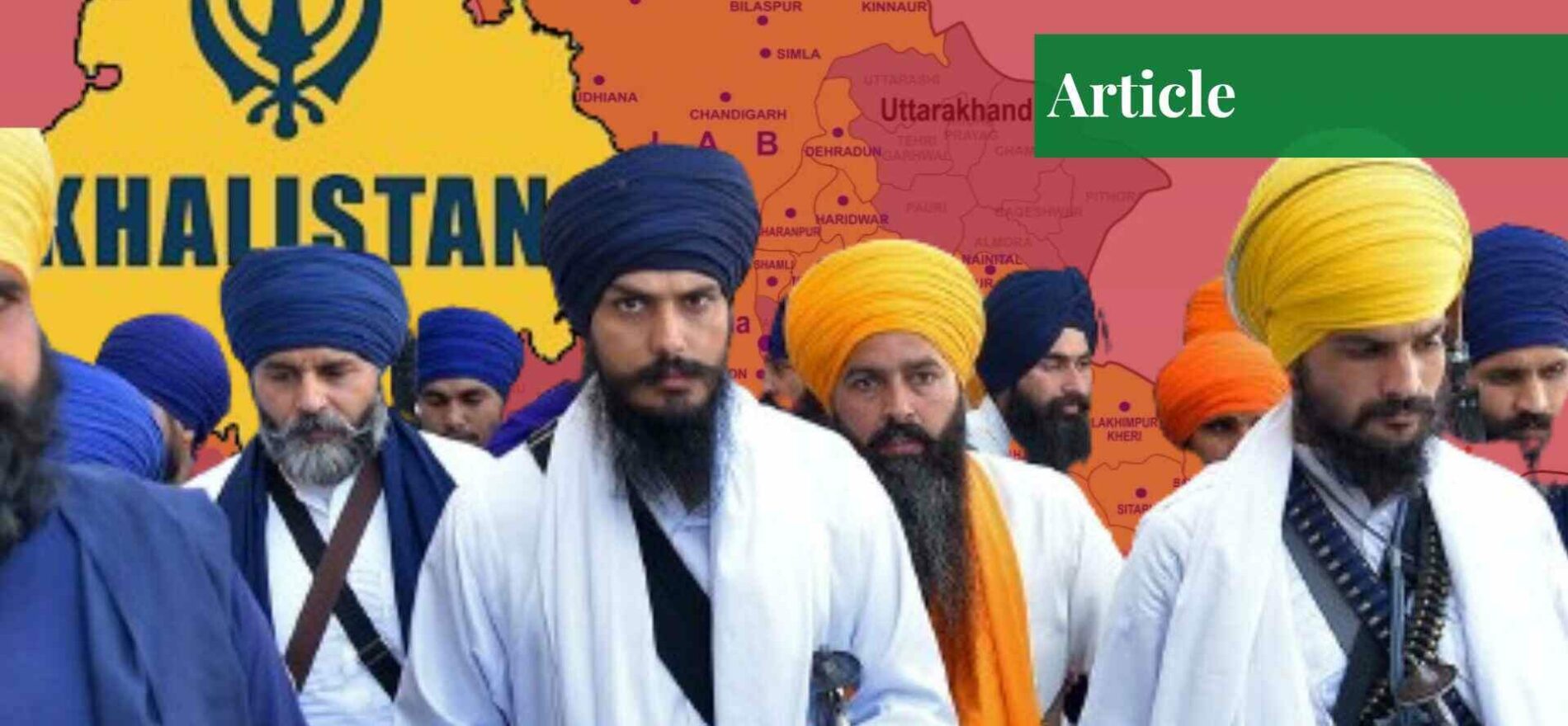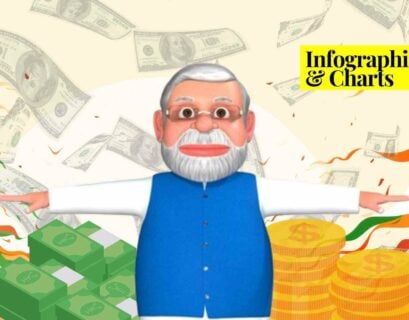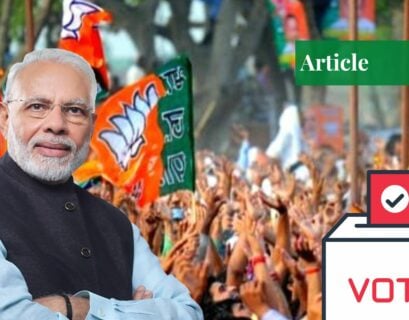Sarmad Ishfaq is an independent researcher and writer whose work has been published by Harvard Kennedy School Review, The Diplomat, Open Democracy, Paradigm Shift, Mondoweiss, and Eurasia Review to name a few. He has also been published by several international peer-reviewed journals such as Taylor and Francis' Social Identities. Before becoming an independent writer, he worked as a research fellow for the Lahore Center for Peace Research. He has a master's degree in International Relations from the University of Wollongong in Dubai where he was recognized as the 'Top Graduate'.
Introduction
In June of 2023, Hardeep Singh Nijjar was murdered outside a Sikh temple, and this was done allegedly due to his vocal advocacy of the Khalistan movement—an independent Sikh homeland desired by Khalistani Sikhs. Placed in an undesirable situation after the murder took place in a Vancouver suburb, Canada and India have been at each other’s throats.
Canadian Prime Minister Justin Trudeau was hasty in his allegations, stating that India was the mastermind behind this brutal killing. While Nijjar was a freedom fighter to Khalistani Sikhs, to India he was a terrorist due to the state’s historic anathema towards the Khalistan movement. India’s diplomatic tensions have been rising with Canada as the latter recently added India’s name to an election interference probe as well.
The Khalistan Movement and Bhindranwale
While the Khalistan movement climaxed during the 1980s, it existed in some form even before 1947. Ironically, the leader of the Khalistan movement, Jarnail Singh Bhindranwale, never wanted an independent/separate Sikh state; rather, he wanted the Indian government to give Sikhs their due political and social rights.
In the 1980s, the situation in Indian Punjab was disorderly due to shootings, arson, and bombings by Sikh militants. In response, Punjab’s security apparatus was heavy-handed, leading to an environment of overwhelming anger and resentment in the Sikh masses against the authorities. This paved the way for Bhindranwale and added to his fame.
In 1982, Bhindranwale and his followers made the holiest site in Sikhism, the Golden Temple, their headquarters. The government perceived this move as one that challenged its writ and began to float the idea of attacking the Golden Temple. While a contentious figure in India still, at the time there was little evidence to justify a military operation against him in the temple complex.
“It’s shocking that we have so little against him while we keep blaming him for all sorts of things. You certainly cannot assault the temple based on just these charges, get hundreds of people killed, and get away with it.”
A senior officer in Chandigarh
Those blessed with precognition stated that attacking the Golden Temple would fan the flames of Khalistanism. For example, a non-Sikh bureaucrat in Chandigarh said “I hope to God the Government does not do it [invade the Golden Temple Complex]. It will mean laying the foundations of Khalistan.”
Operation Blue Star
Before the operation started, the government attempted negotiations, but these failed. Consequentially, in 1984, Indira Gandhi, the then-PM, ordered Operation Blue Star to be launched in the Golden Temple and other Sikh gurdwaras across Punjab. This proved disastrous as the Indian military and government’s implementation was severely flawed. The military utilized artillery, tanks, and thousands of soldiers to fight a much smaller Sikh militant force at the Golden Temple.
While there are various estimates of the casualties, the most reliable figures claim that the total number of deaths ranges from 5,000 to 7,000. The most tragic occurrence, however, was that besides soldiers and militants, thousands of civilians perished in the operation. A banned report in India titled “Oppression in Punjab” relied on eyewitness accounts to narrate the horrific tragedy. This report heavily contradicts the propagandized version that the Indian government disseminated via its 1984 white paper.
A major miscalculation on the military’s part was that it conducted its operation when the temple was full of pilgrims, due to the martyrdom anniversary of the fifth Sikh Guru. Eyewitnesses stated that the Indian government did not prevent Sikh pilgrims from entering the Golden Temple even when it was aware that a military operation was imminent. Once the pilgrims were done performing their religious rites, the security forces banned their exit due to a government-imposed curfew—and people who managed to exit were arrested.
Eyewitnesses also shared that the Indian army initiated the firing and not the militants, as touted by government sources. Moreover, the pilgrims were not given a warning when the army was initiating its attack. Helicopters, artillery, and a plethora of well-equipped soldiers stormed the Golden Temple. One eye-witness reported, “We saw a large number of boys blown to pieces.”
Adding to this belligerent and indiscriminate ingress, the government also barred the Red Cross as well as the press from entering. This was done to prevent the world from witnessing the ignominious human rights abuses that the Indian military committed. When the operation concluded and the blood-laden dust settled, the Indian forces arrested the surviving pilgrims and subjected them to torture.
Indira Gandhi’s Assassination & the Sikh Pogrom
With the Sikhs outraged over their brethren being killed and their holiest site being desecrated, the popularity of the Khalistan movement exploded post-Blue Star. In this environment of hatred, two Sikh bodyguards brutally murdered Indira Gandhi. The assassins Satwant Singh and Beant Singh fired 33 bullets, 30 of which hit her. While India is no stranger to communal/religious clashes as well as independence movements, Indira’s slaying initiated one of the country’s most traumatic episodes of communal violence ever.
Enraged Hindus began attacking and killing thousands of Sikhs. According to independent estimates, the 1984 Sikh massacre claimed the lives of 8,000 to 17,000 Sikhs. During all this madness, it was found that India’s state machinery itself (and Congress members) planned and implemented these pogroms. In one instance, Delhi’s police overlooked Hindu rioters that raped and murdered Sikhs. These riots which plagued India from October 31st to November 3rd, 1984 are infamous for being the largest pogrom in independent India’s history.
Despite the enormous casualties, only a few low-level policemen and politicians were prosecuted. Even to this day, Sikh families have not been able to find justice through Indian courts. This distressing time upsurged Sikh militancy further throughout Punjab in the 1980s and the demands for Khalistan soared. The Sikhs now wanted an independent homeland and would not make do with greater autonomy within India.
While India eventually did manage to extinguish the flames of Khalistan in Punjab during the 1990s, during this period many Sikhs escaped to Canada, Australia, and the UK for better lives. Since there is greater freedom of speech as well as expression in these first-world countries than in India, the Khalistan cause was exported abroad where it still enjoys great support.
Farmers’ Protest 2020-21 and the K-word
The situation in Punjab gradually improved, Sikh militancy waned, and most Sikhs reconciled with the state. Things, however, did change after the farmers’ protest of 2020-21. The farmers’ protests in India in 2020-21 were a series of protests against 3 Indian farm acts. Many protesters belonged to the Sikh faith and hailed from Punjab. Tensions rose acutely between the protesters and the far-right BJP, and the protests became violent at certain points.
The ultimate act of defiance was when Sikh farmers reached Delhi and managed to raise their flag at the Red Fort. This incensed the BJP, its supporters, and the government’s veritable arm, the Indian media—the latter of which categorized the farmers as Khalistanis. Furthermore, the K-word was used to describe the Sikh protesters in many political speeches as well as on Twitter.
Labeling someone as a “Khalistani” is akin to calling someone a traitor in India, therefore many Sikhs were saddened by such insinuations especially as they were not pushing a Khalistani agenda but were merely expressing displeasure over the BJP’s farm acts. Hindutva supporters began tweeting statements like “Missing Indira Gandhi” and “Repeat 1984” even when allegations that the protests had been infiltrated by Khalistanis were found wanting of any credible evidence.
To undermine Sikh farmers, fake images were being proliferated and the K-word was adopted by the BJP. A 50-year-old Sikh farmer complained, “The Modi media is calling us Khalistanis. We have been sitting peacefully for two months. That makes us terrorists?” On a rare occasion, the BJP conceded to the demands of the farmers and revoked the acts. While these protests stood finished, many Sikhs saw again how poorly the government and other Indians treated them.
Mysterious Sikh Deaths
Deep Sidhu, an actor, and Sikh activist, became a renowned figure when rallying for Sikh rights during the farmers’ protest. He eventually formed the “Waris Punjab De”, a pro-Khalistan party, and before his passing, stood behind the pro-Khalistani leader Simranjit Singh Mann and the Shiromani Akali Dal Amritsar (Sikh nationalist party).
Deep Sidhu died in a road accident where he hit a parked truck. The official story as corroborated by his girlfriend was that he was speeding, but there were a few discrepancies. For example, there were 50-foot-long brake marks which indicated that the truck had performed a hard brake. Furthermore, when the crash took place, pictures emerged on media that showed an alcohol bottle in the car, whereas fact checkers stated that earlier pictures showed nothing of the sort.

Regardless of what transpired, many of Deep’s followers believe Indian security agencies murdered him. This includes his successor, Amritpal Singh. This conspiracy theory outlook is predominant amongst many Sikhs because a myriad of “bothersome” Sikhs were killed extrajudicially or in fake encounters. An America-based Sikh activist group named Ensaaf uncovered evidence of unlawful killings in over 12,000 villages in Punjab to date. There are still, to this day, regular allegations of fake encounters resulting in the deaths/disappearance of Sikhs all over India.
Suspicious deaths of important Sikhs from the past include that of the Khalistani leader Jagdev Singh Khuddian. In 1989, he disappeared from his house; his body was found 6 days later. Furthermore, Bimal Kaur, MP and the wife of Beant Singh, one of the assassins of Indira Gandhi, also died suspiciously in 1991.
In more contemporary times, the immensely popular Punjabi rapper Sidhu Moose Wala was killed in a shooting. Although it was stated that his death was due to gang violence, many Sikhs claim that he was murdered due to his lyrical references to Khalistan. For example, he used footage of Bhindranwale in a song as well as speeches made by Sardar Bharpur Singh Balbir, a Khalistan supporter. Furthermore, he was friends with Deep Sidhu.
After Deep Sidhu passed away, the outspoken Khalistani Amritpal Singh took over “Waris Punjab De” which initiated a crackdown against him in March of 2023. He was later arrested in April for attempted murder amongst other charges. Remarkably, only a few months after Amritpal’s arrest, a series of “coincidental deaths” of Khalistanis took place outside India. This includes, in order:
- Paramjit Singh Panjwar, the Khalistan Commando Force chief.
- Avtar Singh Khanda, a Khalistani based in UK.
- Hardeep Singh Nijjar, the Sikh activist murdered in Vancouver.
They all died within two months. Just before his death, Nijjar alluded to the pattern of Sikh killings.
“You see it has been just a month, and look at the killings. We (Sikhs) need to be vigilant. I am already on the enemy’s target.”
Hardeep Singh Nijjar – Canadian Sikh assassinated on June 13th 2023.
Pramjit Singh Panjwar was assassinated by unknown gunmen in Pakistan in early May 2023, while Avtar died mysteriously in a UK hospital. These foreign killings particularly in Canada and the UK have activated the pro-Khalistanis abroad.
When it comes to Nijjar, there is credibility that Indian diplomats were complicit in his murder with CBC writing, “That intelligence includes communications involving Indian officials themselves, including Indian diplomats present in Canada…The intelligence did not come solely from Canada. Some were provided by an unnamed ally in the Five Eyes intelligence alliance.” Therefore, the farmers’ protests and their aftermath highlighted how “targeting of the Sikh community has only increased…”
Conclusion
India’s procacious operation at the Golden Temple and behaviors in its aftermath gave birth to the demand for a sovereign Sikh state. Had India employed restraint, there might not even be a Khalistan movement today. In 1976, former special secretary of the Research and Analysis Wing, G. B. S. Sidhu, was posted to Ottawa, Canada, to gain intelligence on Khalistan.
Sidhu asserted that nothing was amiss in the Sikh diaspora in North America during the three years of his visit. According to him, the Indian government was needlessly making Khalistan into a menace that it was clearly not. Furthermore, former Indian spymaster, A. S. Dulat, writes that “Khalistan was never a movement and may have remained a chimera, but Bhindranwale dead became much bigger than Bhindranwale alive and Punjab was to witness a decade-and-a-half of terrorism.”
Similarly, India appears to have restarted its persecution of the Sikhs in both Punjab and abroad as there are far too many coincidences vis-à-vis influential Sikh deaths. If this is indeed India’s voracious campaign to eradicate Khalistanism, it lacks logic. The Khalistan movement primarily has a vocal base abroad and is not nearly strong enough to dent India politically, economically, or diplomatically—not without India’s help at least. Therefore, this agitation will backfire as more and more Sikhs turn anti-state and become Khalistani.
In its hubris, I think it is axiomatic that the BJP will continue to undermine Khalistan as it did with the minority rights of Muslims, Christians, and Dalits for the Hindu Rashtra. It has been able to escape iniquities such as revoking Kashmir’s special status, anti-Muslim violence, introducing the Citizenship Amendment Act, and the violence in Manipur to name a few. The one thing it could not get away with was the farm acts. The Sikhs made sure of it.
Furthermore, the BJP is not popular in Punjab and despite its efforts to co-opt the Sikh faith, it has not succeeded. Many Sikhs do not view Modi positively. While Jarnail Singh Bhindranwale never demanded a separate Khalistan state, he rightfully asserted “…if the Indian Government invaded the Darbar Sahib complex, the foundation for an independent Sikh state will have been laid.” Therefore, if India continues to surreptitiously and illegally target Khalistani Sikhs, it is only a matter of time before a resurgence of Khalistan erupts on its soil.
If you want to submit your articles, research papers, and book reviews, please check the Submissions page.
The views and opinions expressed in this article/paper are the author’s own and do not necessarily reflect the editorial position of Paradigm Shift.



















